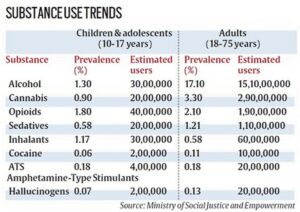Addiction, a complex disorder has affected millions of people worldwide. It is often characterized by compulsive drug-seeking behavior, even in the face of negative consequences. According to American Society of Addiction Medicine, “Addiction is a chronic brain disease that affects the brain’s reward, pleasure, memory, and motivation” (Smith DE, 2011).
While the causes of addiction are multifaceted, many researchers agree that it all starts with pleasure. Many people believe that it is a choice or a moral failing, but research shows it is actually a disease that affects the brain. The brain is rewired by addiction, making it extremely difficult for people to quit using drugs or alcohol, even if they want to. Pleasure is a fundamental aspect of human behavior, and it is associated with the release of dopamine in the brain. Dopamine is a neurotransmitter that is responsible for feelings of pleasure, reward, and motivation. It is released when we engage in activities that are pleasurable, such as eating, exercising, or socializing with friends. Drugs and other addictive substances also stimulate the release of dopamine in the brain, which is what makes them so appealing. However, the brain adapts to the increased levels of dopamine, leading to a cycle of increasing tolerance and the need for more of the drug to achieve the same level of pleasure.
How big the concern is?
In India, the drug abuse has been increasing over the years.
As per the Comprehensive National Survey on Extent and Pattern of Substance Use in India conducted in 2018, the details of drug abuse are as under:

NDTV reports in Dec, 2022, the supreme court’s observation that shockingly 1.58 crore children aged between 10 and 17 years are addicted to substances in the country. “About 16 crore people consume alcohol and more than 5.7 crore individuals are affected by harmful or dependent alcohol use and need help.”
What are the causes of influence to addiction?
Addiction is a complex disorder that is influenced by various factors. Researchers have identified several causes of addiction that can be classified into biological, environmental, and social factors. Understanding the underlying causes of addiction can help to prevent and treat this disorder effectively.
1. Biological Causes of Addiction
a. Genetics: Genetic factors play a significant role in addiction. Research has shown that addiction tends to run in families, indicating that genes play a role in the development of addiction. As per a study conducted, it was concluded that 40 to 60% alcoholics had it in their genes (Dick DM & Foroud T., 2013). There is also significant overlap in the genetic vulnerability to alcohol and nicotine dependence, especially in heavy drinkers and smokers (26); about 50% of the genetic liability to nicotine dependence is shared with alcoholism and 15% of the genetic liability to alcoholism is shared with nicotine dependence (Goldman D, Oroszi G, Ducci F.). Similarly, there are research supporting the evidence that addiction is a disease which can be carried through in our genes and not only impacts us but can also take a toll on the future generation.
b. Brain Chemistry: Addiction involves changes in brain chemistry that affect reward, pleasure, and motivation. When a person engages in addictive behavior, such as using drugs, the brain releases neurotransmitters such as dopamine, which creates a feeling of pleasure and reinforces the behavior.
2. Environmental Causes of Addiction
a. Stressful Life Events: Stressful life events, such as divorce, loss of a job, or the death of a loved one, can trigger addiction. These events can lead to feelings of depression, anxiety, or hopelessness, which can be relieved by engaging in addictive behavior.
b. Trauma: Trauma, such as physical or sexual abuse, can also lead to addiction. Trauma can lead to post-traumatic stress disorder (PTSD), which can be treated with drugs or alcohol, leading to addiction.
c. Peer Pressure: Peer pressure is a significant factor in addiction, especially among adolescents. Peer pressure can lead to experimentation with drugs and other addictive substances, leading to addiction.
3. Social Causes of Addiction
a. Social Acceptance: Social norms and acceptance can influence addiction. For example, drinking alcohol is socially acceptable in many cultures, leading to higher rates of alcohol addiction.
b. Lack of Social Support: A lack of social support can also contribute to addiction. People who feel isolated, lonely, or unsupported may turn to drugs or alcohol to cope with their emotions.
How does addiction build up?
Addiction is a progressive disease that gradually takes over our mind, body and brain. It happens in the stages hidden behind our conscious mind and plays its game. While not everyone will experience all of these stages, they can provide a useful framework for understanding the progression of addiction.
Stage 1: Experimentation: As we were discussing above that it all starts with pleasure. When we are young and vibrant, we always want to experiment with new experiences especially the drugs as we see it to be a part of what mostly people perceive it having a cool and easy-going personality. Therefore, out of curiosity or peer pressure, we start with a cigarette or a beer and even in some cases a Joint (Cannabis). While most people who experiment with drugs will not develop an addiction, it can be a slippery slope for some.
Stage 2: Regular Use: Once we have tried or experimented with a substance, it kind of remains with us as no doubt the amount of dopamine released in the first time encourages or motivates us to use them again. Hence, a teenager or a young adult starts to find out ways to use them again, might even bunk from a class or college just to get that one doobie and the pleasure it brings with it which makes us “look cool” in our group.
Stage 3: Tolerance: With the regular use, the substance (a drug or alcohol or nicotine), starts regulating our reward cycle. It creates a need for higher doses so as to reach that “optimal high” or the exact amount of dopamine required to achieve the same level of pleasure. This is the stage where the brain begins to adapt to the increased levels of dopamine, leading to changes in behavior and thought patterns.
Stage 4: Risky Use: Now, the person has already reached to a stage where the thought patterns and behaviours are changing allowing the substance to master us and make us their slaves. The person starts high risk behaviours such as driving, bar fights, operating heavy machinery etc. This stage is often characterized by an inability to control drug use and a disregard for the negative consequences that may arise. Here the substance use becomes substance abuse as it starts eating the person’s consciousness and will to work and live life to the fullest.
Stage 5: Dependence: Now, the person is actually dependent on the substance, no matter what if they do not use the substance their mind and body will start showing withdrawal symptoms and they will start suffering from various problems such as nausea, dizziness, headaches, tremors, seizures, irritation, aggression and many more. This stage is often marked by a strong craving for the drug and an inability to function normally without it.
Stage 6: Addiction: You might be knowing or have seen people suffering from issues like severe coughing and chest congestion but still smoking a cigarette or a joint. That is because they have reached the final stage of substance abuse i.e., the addiction. It is the most severe form of substance abuse and is characterized by compulsive drug-seeking behavior, even in the face of negative consequences. It is often accompanied by changes in mood and behavior, including irritability, depression, and anxiety.
How does the addiction impact?
Addiction can have a wide range of effects on both the person who is struggling with addiction and the people around them. These effects can be physical, psychological, and social.
Impact on the abuser:
- Physical Health: Addiction can lead to a range of physical health problems, such as liver disease, heart disease, and lung disease. Intravenous drug use can also lead to infectious diseases such as HIV and hepatitis.
- Mental Health: Addiction can lead to mental health problems such as anxiety, depression, and psychosis. These mental health problems can worsen the addiction, creating a vicious cycle.
- Financial Problems: Addiction can be expensive, and people struggling with addiction may struggle to maintain employment or may use up their savings to support their addiction.
- Legal Problems: Substance abuse can lead to legal problems, including arrests, fines, and imprisonment.
- Relationship Problems: Addiction can damage relationships with friends, family members, and romantic partners. People struggling with addiction may lie, steal, or engage in other behaviors that damage these relationships.
Impact on people in relation to abuser:
- Emotional Distress: The loved ones of people struggling with addiction may experience a range of emotions, including anger, frustration, sadness, and helplessness.
- Financial Burden: Addiction can also affect the finances of family members, particularly if they are supporting the person struggling with addiction.
- Social Stigma: Family members and friends may experience social stigma as a result of their loved one’s addiction. They may feel ashamed, embarrassed, or isolated.
- Mental Health Problems: The stress of dealing with a loved one’s addiction can lead to mental health problems, including anxiety, depression, and trauma.
- Physical Health Problems: Family members may experience physical health problems as a result of their loved one’s addiction, such as stress-related illnesses or injuries resulting from violence or accidents.
What is the solution to addiction?
Drug addiction is a complex problem that requires a multi-faceted approach for effective solutions. Here are some possible ways to address the concern of drug addiction:
- Prevention: One of the most effective ways to address drug addiction is by preventing it from happening in the first place. This can be done through education, public awareness campaigns, and early intervention programs targeted towards vulnerable populations.
- Treatment: People struggling with drug addiction need access to effective treatment. This may include medication-assisted treatment, counseling, and behavioral therapies that help individuals recover from addiction.
- Support: Support groups and recovery programs can be incredibly helpful for individuals in recovery. These programs provide a community of support and a safe space for individuals to share their experiences and challenges.
- Regulation: Government regulation of drug production and distribution can help reduce the availability of addictive substances and prevent the development of addiction in the first place.
- Research: Continued research into the causes and treatment of drug addiction can lead to more effective interventions and strategies for prevention and recovery.
It’s important to note that drug addiction is a complex and individualized issue, and the most effective solutions should be tailored to each person’s unique situation. Hence, it is crucial to understand that addiction is a disease that requires ongoing management. Even after achieving sobriety, it is important to remain vigilant and continue to work on recovery. This may involve attending support groups, practicing self-care, and avoiding triggers that could lead to relapse.
References
- Smith, David E. “Editor’s note: The process addictions and the new ASAM definition of addiction.” Journal of psychoactive drugs1 (2012): 1-4.
- (2022, December 14). 1.58 Crore in 10-17 Age Group Addicted To Drugs: Centre To Supreme Court. https://www.ndtv.com/india-news/1-58-crore-in-10-17-age-group-addicted-to-drugs-centre-to-supreme-court-3606777
- Drug addiction (2022, JUL19). https://pib.gov.in/PressReleasePage.aspx?PRID=1842697
- Edenberg HJ, Foroud T. Genetics and alcoholism. Nat Rev Gastroenterol Hepatol. 2013 Aug;10(8):487-94. doi: 10.1038/nrgastro.2013.86. Epub 2013 May 28. PMID: 23712313; PMCID: PMC4056340. https://www.ncbi.nlm.nih.gov/pmc/articles/PMC4056340/
- Goldman, D., Oroszi, G., & Ducci, F. (2005). The genetics of addictions: uncovering the genes. Nature reviews. Genetics, 6(7), 521–532. https://doi.org/10.1038/nrg1635, https://pubmed.ncbi.nlm.nih.gov/15995696/
Author
Jatin Khurana

Started his career as a Navigation Officer in Merchant Navy to working in various roles in start-ups as well as established companies, Jatin had tasted the flavor of various professional avenues and decided to finally land up to becoming a full-time psychologist. He is presently pursuing MA in Psychology and PG Diploma in Guidance and Counselling from Jamia Millia Islamia University. He has also done an internship with the esteemed Institute of Human Behavior and Allied Sciences (IHBAS).
Jatin successfully runs a mental health service, Speakyourmind.in (http://www.speakyourmind.in/). The aim of Speakyourmind.in, is to provide mental health support to individuals and communities in need. He has conducted workshops and sessions on Stress Management in various organizations.
Jatin believes that mental health awareness is essential for the overall well-being of individuals and society, and he strives to make a positive impact through his work. In his free time, Jatin enjoys creating Mandala Art, reading books on psychology, and practicing mindfulness meditation. He hopes to use his knowledge and skills to make a positive impact on the lives of others.



